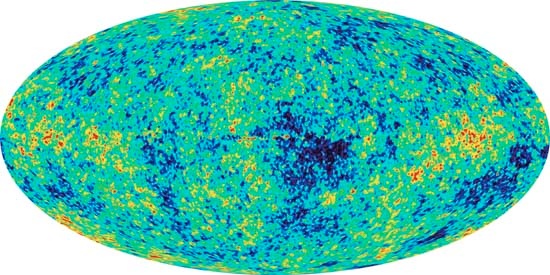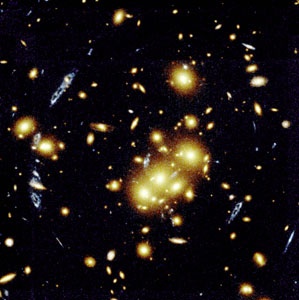cosmology
astronomy
 field of study that brings together the natural sciences, particularly astronomy and physics, in a joint effort to understand the physical universe as a unified whole.
field of study that brings together the natural sciences, particularly astronomy and physics, in a joint effort to understand the physical universe as a unified whole.A brief treatment of cosmology follows. For full treatment, see astronomy: Cosmology (astronomy); Cosmos.
Three great ages of scientific cosmology can be distinguished. The first began in Greece in the 6th century BC when the Pythagoreans introduced the concept of a spherical Earth and, unlike the Babylonians and Egyptians, postulated a universe in which the motions of heavenly bodies were governed by the harmonious relations of natural laws. The infinite atomist universe of Leucippus and Democritus followed, wherein countless worlds, teeming with life, were the result of chance aggregations of atoms. The geocentric Aristotelian (Aristotle) universe arose in the 4th century BC. It consisted of a central Earth surrounded by revolving, translucent spheres to which were attached the Sun and the planets; the outermost sphere supported the fixed stars. Various developments culminated in the Ptolemaic model of the 2nd century AD, and in the 13th century the Aristotelian universe was adapted to Christian theology by Thomas Aquinas.
The Copernican revolution ushered in the second great age. In the 16th century, Nicolaus Copernicus revived ancient ideas and proposed a heliocentric universe, which during the following century was transformed into the mechanistic, infinite Newtonian universe that flourished until the early 1900s. In the mid-18th century, Thomas Wright proposed the influential notion of a universe composed of numerous galaxies, and William Herschel, followed by many other astronomers, made rapid strides in the study of stars and of the Milky Way Galaxy, of which the Earth is a component.
The third great age began in the early years of the 20th century, with the discovery of special relativity and its development into general relativity by Albert Einstein. These years also saw momentous developments in astronomy: extragalactic redshifts were detected by Vesto Slipher; extragalactic nebulae were shown to be galaxies comparable with the Milky Way; and Edwin Hubble began to estimate the distances of these galactic systems. Such discoveries and the application of general relativity to cosmology by Wilhelm de Sitter, Alexander Friedmann, and Georges Lemaître eventually gave rise to the view that the universe is expanding (expanding universe). The basic premise of modern cosmology is the principle that asserts that the universe is homogeneous in space (on the average all places are alike at any time) and that the laws of physics are everywhere the same. The principle is plausible because of the observed isotropy of the universe (on the average all directions are alike).
 The essence of general relativity, when applied to standard cosmological models, is that space has dynamic properties and may be uniformly curved. If the curvature is negative (hyperbolic) or zero (flat), the universe is open and space is infinite; if the curvature is positive (spherical) the universe is closed and space is finite. Space itself expands, and the galaxies, stationary in space, recede from one another; all recession velocities, relative to any co-moving observer, obey the Hubble law (Hubble's constant) (see Hubble's constant), and their increase with distance is not limited by the velocity of light. Light rays, while propagating through expanding space, have their wavelengths progressively stretched; the light emitted by a distant galaxy is thus received at longer wavelengths, and this is the origin of cosmological redshifts. Expansion indicates that the universe originated in a congested state (i.e., the big bang (big-bang model)) some 10,000,000,000 years ago. The steady-state theory—an attempt to eliminate the big bang—has been disproved by the existence of microwave background radiation that is believed to be the afterglow of the big bang. Such thermal radiation (with a temperature of nearly 3 K) was predicted by George Gamow in the early 1950s and discovered by Arno A. Penzias and Robert W. Wilson in 1965. Since then considerable progress has been made in the study of the early universe that lasted for a period of approximately 100,000 years.
The essence of general relativity, when applied to standard cosmological models, is that space has dynamic properties and may be uniformly curved. If the curvature is negative (hyperbolic) or zero (flat), the universe is open and space is infinite; if the curvature is positive (spherical) the universe is closed and space is finite. Space itself expands, and the galaxies, stationary in space, recede from one another; all recession velocities, relative to any co-moving observer, obey the Hubble law (Hubble's constant) (see Hubble's constant), and their increase with distance is not limited by the velocity of light. Light rays, while propagating through expanding space, have their wavelengths progressively stretched; the light emitted by a distant galaxy is thus received at longer wavelengths, and this is the origin of cosmological redshifts. Expansion indicates that the universe originated in a congested state (i.e., the big bang (big-bang model)) some 10,000,000,000 years ago. The steady-state theory—an attempt to eliminate the big bang—has been disproved by the existence of microwave background radiation that is believed to be the afterglow of the big bang. Such thermal radiation (with a temperature of nearly 3 K) was predicted by George Gamow in the early 1950s and discovered by Arno A. Penzias and Robert W. Wilson in 1965. Since then considerable progress has been made in the study of the early universe that lasted for a period of approximately 100,000 years.- Amado Nervo
- Amadou and Mariam
- Amadís of Gaul
- Amagasaki
- amakihi
- Amakusa Islands
- Amalaric
- Amalasuntha
- Amalekite
- Amalfi
- amalgam
- Amalgamated Clothing and Textile Workers Union
- Amalgamated Engineering and Electrical Union
- Amalia Kahana-Carmon
- Amalienborg
- Amalie Skram
- Amalric I
- Amalric II
- Amalthaea
- Amalthea
- Amambaí Mountains
- Amami Great Island
- Amana Colonies
- Amanda Smith
- Amanita